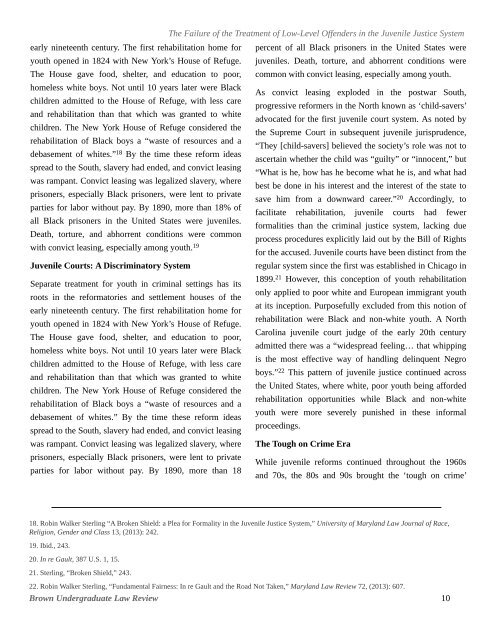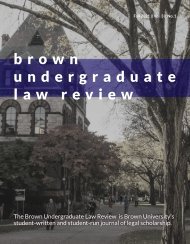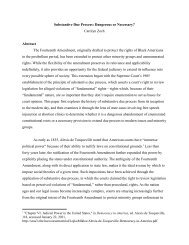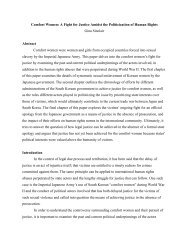Brown Undergraduate Law Review — Vol. 2 No. 2 (Spring 2021)
We are proud to present the Spring 2021 issue of the Brown Undergraduate Law Review. We hope that the works contained herein offer insight and inspiration to all who read them.
We are proud to present the Spring 2021 issue of the Brown Undergraduate Law Review. We hope that the works contained herein offer insight and inspiration to all who read them.
Create successful ePaper yourself
Turn your PDF publications into a flip-book with our unique Google optimized e-Paper software.
The Failure of the Treatment of Low-Level Offenders in the Juvenile Justice System<br />
early nineteenth century. The first rehabilitation home for<br />
youth opened in 1824 with New York?s House of Refuge.<br />
The House gave food, shelter, and education to poor,<br />
homeless white boys. <strong>No</strong>t until 10 years later were Black<br />
children admitted to the House of Refuge, with less care<br />
and rehabilitation than that which was granted to white<br />
children. The New York House of Refuge considered the<br />
rehabilitation of Black boys a ?waste of resources and a<br />
debasement of whites.? 18 By the time these reform ideas<br />
spread to the South, slavery had ended, and convict leasing<br />
was rampant. Convict leasing was legalized slavery, where<br />
prisoners, especially Black prisoners, were lent to private<br />
parties for labor without pay. By 1890, more than 18% of<br />
all Black prisoners in the United States were juveniles.<br />
Death, torture, and abhorrent conditions were common<br />
with convict leasing, especially among youth. 19<br />
Juvenile Courts: A Discriminatory System<br />
Separate treatment for youth in criminal settings has its<br />
roots in the reformatories and settlement houses of the<br />
early nineteenth century. The first rehabilitation home for<br />
youth opened in 1824 with New York?s House of Refuge.<br />
The House gave food, shelter, and education to poor,<br />
homeless white boys. <strong>No</strong>t until 10 years later were Black<br />
children admitted to the House of Refuge, with less care<br />
and rehabilitation than that which was granted to white<br />
children. The New York House of Refuge considered the<br />
rehabilitation of Black boys a ?waste of resources and a<br />
debasement of whites.? By the time these reform ideas<br />
spread to the South, slavery had ended, and convict leasing<br />
was rampant. Convict leasing was legalized slavery, where<br />
prisoners, especially Black prisoners, were lent to private<br />
parties for labor without pay. By 1890, more than 18<br />
percent of all Black prisoners in the United States were<br />
juveniles. Death, torture, and abhorrent conditions were<br />
common with convict leasing, especially among youth.<br />
As convict leasing exploded in the postwar South,<br />
progressive reformers in the <strong>No</strong>rth known as ?child-savers?<br />
advocated for the first juvenile court system. As noted by<br />
the Supreme Court in subsequent juvenile jurisprudence,<br />
?They [child-savers] believed the society?s role was not to<br />
ascertain whether the child was ?guilty? or ?innocent,? but<br />
?What is he, how has he become what he is, and what had<br />
best be done in his interest and the interest of the state to<br />
save him from a downward career.? 20 Accordingly, to<br />
facilitate rehabilitation, juvenile courts had fewer<br />
formalities than the criminal justice system, lacking due<br />
process procedures explicitly laid out by the Bill of Rights<br />
for the accused. Juvenile courts have been distinct from the<br />
regular system since the first was established in Chicago in<br />
1899. 21 However, this conception of youth rehabilitation<br />
only applied to poor white and European immigrant youth<br />
at its inception. Purposefully excluded from this notion of<br />
rehabilitation were Black and non-white youth. A <strong>No</strong>rth<br />
Carolina juvenile court judge of the early 20th century<br />
admitted there was a ?widespread feeling? that whipping<br />
is the most effective way of handling delinquent Negro<br />
boys.? 22 This pattern of juvenile justice continued across<br />
the United States, where white, poor youth being afforded<br />
rehabilitation opportunities while Black and non-white<br />
youth were more severely punished in these informal<br />
proceedings.<br />
The Tough on Crime Era<br />
While juvenile reforms continued throughout the 1960s<br />
and 70s, the 80s and 90s brought the ?tough on crime?<br />
18. Robin Walker Sterling ?A Broken Shield: a Plea for Formality in the Juvenile Justice System,? University of Maryland <strong>Law</strong> Journal of Race,<br />
Religion, Gender and Class 13, (2013): 242.<br />
19. Ibid., 243.<br />
20. In re Gault, 387 U.S. 1, 15.<br />
21. Sterling, ?Broken Shield,? 243.<br />
22. Robin Walker Sterling, ?Fundamental Fairness: In re Gault and the Road <strong>No</strong>t Taken,? Maryland <strong>Law</strong> <strong>Review</strong> 72, (2013): 607.<br />
<strong>Brown</strong> <strong>Undergraduate</strong> <strong>Law</strong> <strong>Review</strong><br />
10










